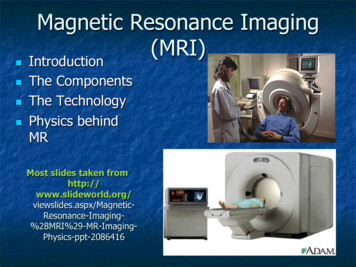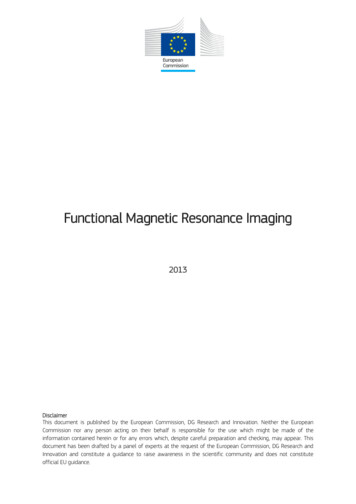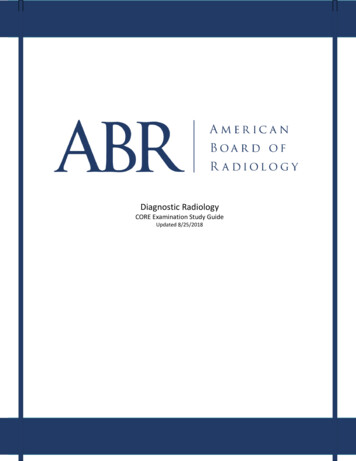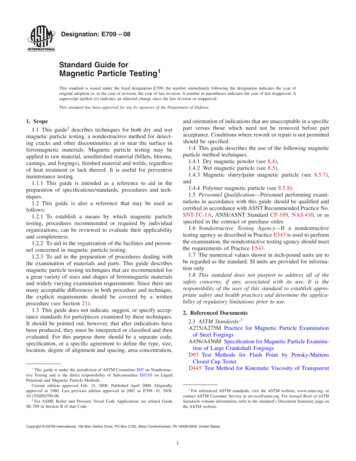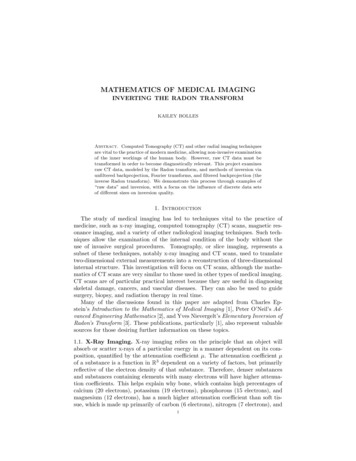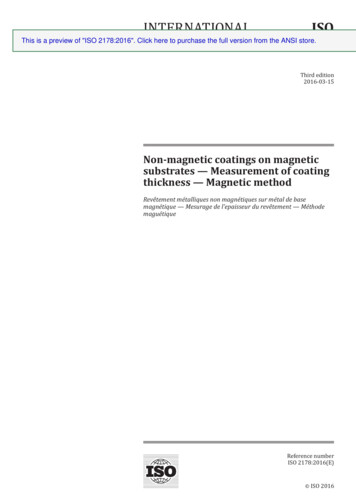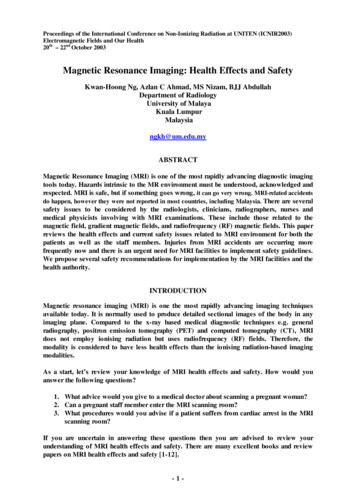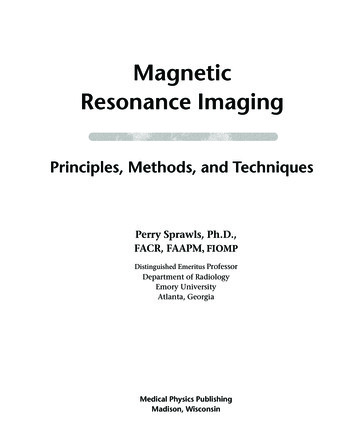
Transcription
MagneticResonance ImagingPrinciples, Methods, and TechniquesPerry Sprawls, Ph.D.,FACR, FAAPM, FIOMPDistinguished Emeritus ProfessorDepartment of RadiologyEmory UniversityAtlanta, GeorgiaMedical Physics PublishingMadison, Wisconsin
Copyright 2000 by Perry SprawlsAll rights reserved.ISBN 13: 0-944838-97-6ISBN 10: 0-944838-97-912 10 08 065 4 3 2Special printing for Sprawls Educational FoundationLibrary of Congress Cataloging-in-Publication DataSprawls, Perry.Magnetic resonance imaging : principles, methods, and techniques / Perry Sprawls.p. ; cm.Includes index.ISBN 0-944838-97-91. Magnetic resonance imaging. I. Title.[DNLM: 1. Magnetic Resonance Imaging--methods. 2. Health Physics. WN 185S767m 2000]RC78.7.N83 S68 2000616.07'548--dc2100-034862Perry Sprawls grants permission for photocopying for limited personal use and making slides foreducational presentations if the source is fully acknowledged. This consent does not extend to otherkinds of copying, such as copying for general distribution, for advertising or promotional purposes,for creating new collective works, or for resale.For information, address Perry Sprawls, at sprawls@emory.edu.Every reasonable effort has been made to give factual and up-to-date information tothe reader of this book. However, because of the possibility of human error and thepotential for change in the medical sciences, the author, publisher, and any otherpersons involved in the publication of this book cannot assume responsibility forthe validity of all materials or for the consequences of their use.Medical Physics Publishing4513 Vernon BoulevardMadison, WI 53705-4964Printed in the United States of America
DedicationThe power of knowledge is realized when it is sharedwith others and used to benefit all peoplewith improved health and quality of life.This book is providedBy theSPRAWLS EDUCATIONAL FOUNDATIONhttp://www.sprawls.orgIn Partnership with Institutions and Faculties Worldwide to Enhancethe Learning and Teaching of Medical Imaging Physics, Engineering,and Technology
ContentsPreface .xvAcknowledgments .xviMind Maps .xvii1Magnetic Resonance Image CharacteristicsIntroduction And Overview .1The MR Image .2Tissue Characteristics and Image Types.3Proton Density (PD) Images .3Magnetic Relaxation Times —T1 and T2 Images.3Fluid Movement and Image Types .3Vascular Flow .3Perfusion and Diffusion .3Spectroscopic and Chemical Shift.3What Do You See In An MR Image?.4Radio Frequency Signal Intensity .4Tissue Magnetization.4Protons (Magnetic Nuclei).4Hydrogen.5Tissue Characteristics.5PD (Proton Density) .6T1.6T2.6Spatial Characteristics .6Slices .6Voxels.6Image Pixels .6Control Of Image Characteristics.7Contrast Sensitivity.7Detail .8Noise.9Artifacts.9Spatial .11Image Acquisition Time.11Protocol Optimization.11Mind Map Summary .12vii
2Magnetic Resonance Imaging System ComponentsIntroduction And Overview .13Tissue Magnetization.13Tissue Resonance.14The Magnetic Field .14Field Direction .14Field Strength.15Homogeneity .15Magnets .15Superconducting .15Resistive .16Permanent .16Gradients .16Gradient Orientation .17Gradient Functions .17Gradient Strength .18Risetime and Slew-Rate.18Eddy Currents .18Shimming .18Magnetic Field Shielding.19Passive Shielding .19Active Shielding.20The Radio Frequency System.20RF Coils .20Transmitter.20Receiver.21RF Polarization.21RF Shielding .21Computer Functions .21Acquisition Control.21Image Reconstruction.22Image Storage and Retrieval .22Viewing Control and Post Processing .22Mind Map Summary .233Nuclear Magnetic ResonanceIntroduction And Overview .25Magnetic Nuclei .25Spins .26RF Signal Intensity .26Relative Signal Strength.27Tissue Concentration of Elements .27viiiMAGNETIC RESONANCE IMAGING
Isotopic Abundance.28Relative Sensitivity and Signal Strength.28Radio Frequency Energy.28Pulses .28Signals .28Nuclear Magnetic Interactions .28Nuclear Alignment .28Precession and Resonance .29Excitation .29Relaxation .30Resonance .30Larmor Frequency .31Field Strength.31Chemical Shift .32Mind Map Summary .334CONTENTSTissue Magnetization And RelaxationIntroduction And Overview .35Tissue Magnetization .36Magnetic Direction.36Magnetic Flipping .36Flip Angle .36The 90 Pulse, Saturation and Excitation .36Longitudinal Magnetization And Relaxation .37T1 Contrast .39Molecular Size .39Magnetic Field Strength Effect.40Transverse Magnetization And Relaxation.40T2 Contrast .41Proton Dephasing .43T2 Tissue Characteristics .43T2* Magnetic Field Effects.43Magnetic Susceptibility .44Contrast Agents.45Diamagnetic Materials.45Paramagnetic Materials .45Superparamagnetic Materials .46Ferromagnetic Materials .46Mind Map Summary .47ix
x5The Imaging ProcessIntroduction And Overview .49k Space .49Acquisition .49Reconstruction .50Imaging Protocol .50Imaging Methods .50The Imaging Cycle .51TR .52TE.52Excitation .53The Echo Event and Signals .53Contrast Sensitivity .53T1 Contrast .53Proton Density (PD) Contrast .55T2 Contrast .56Mind Map Summary .586Spin Echo Imaging MethodsIntroduction And Overview .59The Spin Echo Process.59RF Pulse Sequence .61The Spin Echo Method.61Proton Density (PD) Contrast .62T1 Contrast .62T2 Contrast .63Multiple Spin Echo .63Inversion Recovery .64T1 Contrast.65Mind Map Summary .677Gradient Echo Imaging MethodsIntroduction And Overview .69The Gradient Echo Process .69Small Angle Gradient Echo Methods .71Excitation/Saturation-Pulse Flip Angle .71Contrast Sensitivity.73T1 Contrast.73Low Contrast .75Proton Density (PD) Contrast .75T2 and T2* Contrast .75MAGNETIC RESONANCE IMAGING
Contrast Enhancement .75Mixed Contrast.76Spoiling and T1 Contrast Enhancement .76Echo Planar Imaging (EPI) Method .76Gradient And Spin Echo (GRASE) Method .77Magnetization Preparation .78Mind Map Summary .808Selective Signal SuppressionIntroduction And Overview .81T1-Based Fat And Fluid Suppression .81STIR Fat Suppression.82Fluid Suppression .83SPIR Fat Suppression .84Magnetization Transfer Contrast (MTC) .85Free Proton Pool.86Bound Proton Pool .86Magnetization Transfer .86Selective Saturation .86Regional Saturation.86Mind Map Summary .889Spatial Characteristics of the Magnetic Resonance ImageIntroduction And Overview .89Signal Acquisition.91Image Reconstruction .91Image Characteristics .91Gradients .91Slice Selection .91Selective Excitation.92Multi-Slice Imaging .92Volume Acquisition.93Frequency Encoding .94Resonant Frequency .95Phase-Encoding .96The Gradient Cycle .98Image Reconstruction .99Mind Map Summary .101CONTENTSxi
101112xiiImage Detail And NoiseIntroduction And Overview .103Image Detail .104Noise Sources .106Signal-To-Noise Considerations .106Voxel Size .106Field Strength.106Tissue Characteristics.107TR and TE .107RF Coils .108Receiver Bandwidth.109Averaging.109Mind Map Summary .111Acquisition Time And Procedure OptimizationIntroduction And Overview .113Acquisition Time .113Cycle Repetition Time, TR .115Matrix Size.115Reduced Matrix in Phase-Encoded Direction.116Rectangular Field of View.116Half Acquisition.116Signal Averaging .117Protocol Factor Interactions.118Developing An Optimized Protocol .119Contrast Sensitivity.119Image Detail.119Spatial Characteristics and Methods .119Image Noise .119Artifact Reduction.120Fast Acquisition Methods .120Mind Map Summary .122Vascular ImagingIntroduction And Overview .123Time Effects .124Flow-Related Enhancement (Bright Blood).124Flow-Void Effect (Black Blood) .125Selective Saturation.126Phase Effects .126Intravoxel Phase .128Flow Dephasing.129MAGNETIC RESONANCE IMAGING
Flow Compensation .129Even-Echo Rephasing.129Intervoxel Phase .130Phase Imaging .130Artifacts .130Angiography.131Phase Contrast Angiography .131Velocity.132Flow Direction .132In-Flow Contrast Angiography .133Three-Dimension (3-D) Volume Acquisition.133Two-Dimension (2-D) Slice Acquisition .134Image Format.134Maximum Intensity Projection (MIP) .134Surface Rendering.135Contrast Enhanced Angiography .135Mind Map Summary .13613Functional ImagingIntroduction And Overview .137Diffusion Imaging .137Brownian Motion and Diffusion .137Diffusion Coefficient .138Apparent Diffusion Coefficient (ADC) .138Diffusion Direction .139The Imaging Process .139Diffusion Sensitivity .140Diffusion-Weighted Images.141ADC Map Images .141Blood Oxygenation Level Dependent (BOLD) Contrast .141Perfusion Imaging .142Mind Map Summary .14414Image ArtifactsIntroduction And Overview .145Motion-Induced Artifacts .146Phase-Encoded Direction.147Cardiac Motion .147Triggering.147Flow Compensation .147Respiratory Motion.147Averaging .148CONTENTSxiii
Ordered Phase-Encoding .148Regional Presaturation .149Flow .149Regional Presaturation .149Flow Compensation .149Aliasing Artifacts.150Chemical-Shift Artifacts .150Field Strength.151Bandwidth .151Mind Map Summary .15315MRI SafetyIntroduction And Overview .155Magnetic Fields.155Physical Characteristics .156Biological Effects.156Internal Objects.157External Objects .157Magneto-electrical Effects.157Activation of or Damage to Implanted Devices .158Gradients .158RF Energy.159Specific Absorption Rate (SAR).160Magnetic Field Strength.161Pulse Flip Angles .161Pulses per Cycle .161TR.161Determining the SAR for a Patient .161Surface Burns .161Acoustic Noise .161Mind Map Summary .162Index.165xivMAGNETIC RESONANCE IMAGING
PrefaceThe technologists who perform the examinations need a good knowledge and understanding of the total process so that they canselect and modify protocols as necessary, monitor and optimize image quality, and providefor patient and staff safety.Medical physicists who provide support tothe clinical activities with respect to imagequality and procedure optimization, and conduct educational activities for other medicalprofessionals must also have a broad knowledge at the practical and applied levels.This book is designed to meet the needs ofall who play a role in the MR imaging process.First, it develops the very important conceptsof the physical principles on which MR imaging is based. It then builds an understanding ofthe various methods and techniques that arethe heart of each imaging procedure. It givesspecial emphasis to image quality and the associated issues of optimizing protocols. Safety concerns are addressed in order to have an informed staff who can take a realistic approachto reducing risk and increasing patient comfortand acceptance.The objective of this book is to help all ofus obtain maximum performance and benefitfrom the advanced and sophisticated MR technology that is available today. Humans withthe knowledge of how to apply the variousimaging options to the wide range of clinicalneeds is, and will continue to be, a vital link inthe total MR imaging process.Magnetic resonance imaging (MRI) is a majormedical diagnostic tool. It makes it possible tovisualize and analyze a variety of tissue characteristics, blood
Magnetic resonance imaging (MRI) is a major medical diagnostic tool. It makes it possible to visualize and analyze a variety of tissue charac-teristics, blood flow and distribution, and sev-eral physiologic and metabolic functions. Much of this power comes from the ab
